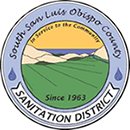The wastewater collected within the District’s Trunk Sewer Line begins the treatment process in the influent pumping plant. There it is passed through a Parshall metering flume to measure the quantity of influent wastewater to the plant. Currently, average annual daily flow at the plant is on the order of 2.88 million gallons per day (mgd), with peak day dry weather flow of approximately 3.37 mgd and peak hour wet weather flows of 8.03 mgd.
Once measured, the wastewater passes through an in-channel screen to mechanically separate and remove the larger debris. Typically this debris consists of sticks, rags, large food particles, paper products, etc. The removed debris is collected, ground, and hauled offsite to a landfill for disposal. The screened wastewater is then distributed to the primary clarifiers by means of the four raw sewage pumping units located within the pumping station.
Prior to arrival at the clarifiers the wastewater enters the clarifier control box. Under normal operations, the control box is designed to separate the waste stream into equal parts for distribution into one of the two primary clarifiers. The control box has the added function of isolating flow to either of the independent clarifiers during periods of maintenance and repairs.
Clarification is achieved at the plant by means of two identical primary clarifiers; one constructed as part of the original 1965 project and the other as part of the 1990 expansion. Each primary clarifier is 55 feet in diameter with a side wall depth of 9 feet. These dimensions allow for a combined volume of 320,625 gallons. Under average annual daily flow, the combined overflow rate of the clarifiers is 610gpd/sf and the combined detention time between the clarifiers is 2.65 hours.
The clarifiers serve to separate a large portion of the suspended solids from the waste stream. This is achieved by maintaining quiescent flow throughout detention, allowing for the heavier solids (sludge) to sink to the bottom of the tank and the lighter solids (scum) to rise to the surface.
The sludge which accumulates on the bottom of the tank is raked continuously towards the center column by a steel raking mechanism. This raking mechanism forces the sludge out of the clarifier through a sludge pocket near the center of the tank. The scum is removed from the clarifier by means of a skimmer assembly attached to one of the arms of the raking mechanism. As the skimmer arm revolves around the tank, scum is guided into a trough attached to the inside of the launder wall. The scum trough removes the scum from the tank and combines it with the sludge removed by the rakes. The removed sludge and scum are pumped to the plant digesters for treatment. The clarified wastewater eventually discharges over the effluent weirs and flows to the fixed film reactor to receive secondary treatment.
Secondary treatment is achieved at the plant by means of a single, fixed film reactor (FFR), constructed as part of the 1986 improvement project. The FFR utilizes a bio-filtration process which removes the dissolved organic matter from the wastewater. The FFR is 117 feet in diameter with a plastic media depth of 12 feet. Wastewater is distributed over microorganisms which grow on the plastic media substrate. The microorganisms absorb the organic matter from the wastewater as their food supply, utilizing much of the suspended colloidal and dissolved organic substrate matter for bioassimilation. As organic matter and nutrients are absorbed from the wastewater, the film of microorganisms grows and thickens, periodically sloughing off the plastic media surface. Partially decomposed organic matter, excess sloughed film, and dead film is carried off with the FFR effluent for further clarification in the secondary clarifier unit.
The secondary clarifier unit, constructed as part of the 1986 improvement project, performs much the same operation as the primary clarifier. The unit is 97 feet in diameter and has a side wall depth of 12 feet. These dimensions allow for a total volume of 665,000 gallons. Under average daily flow, the overflow rate of the clarifier is approximately 393gpd/sf and the detention time is 5.5 hours.
The final step in the treatment process at South San Luis Obispo Sanitation County District’s Wastewater Treatment Plant is the disinfection of the treated effluent prior to release through the ocean outfall. This process occurs within the chlorine contact chamber and is achieved by the injection of sodium hypochlorite into the waste stream to kill the majority of all remaining bacteria. Once the wastewaters disinfected, it is discharged from the plant through the ocean outfall line.
For additional information on the ocean outfall line or the biosolids (sludge) handling and treatment at the District’s Wastewater treatment plant, please click on the respective tabs.


